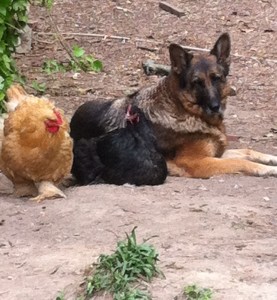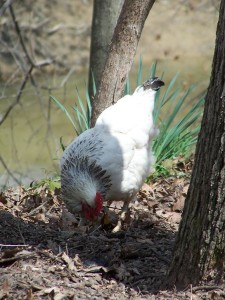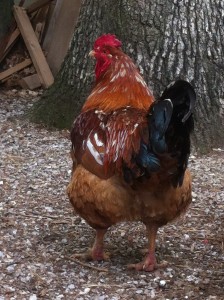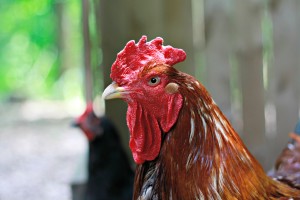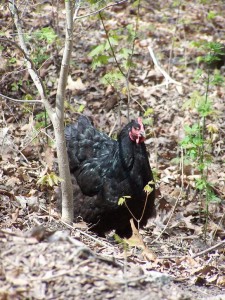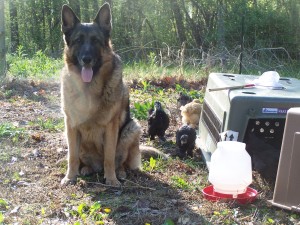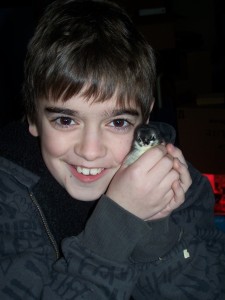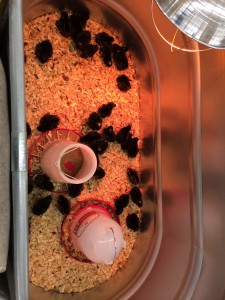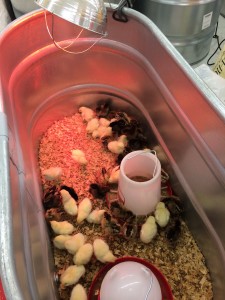CHICK DAYS!
![images[2]](https://simplehobbyhomesteading.com/wp-content/uploads/2017/02/images2.jpg) Chirp… chirp… chirp… do you hear it? I was just heading in for some goat feed and their cute little chirping lured me over to them like a siren’s call. I was hypnotized and before I knew it I was signing my name in the ledger and walking out of the feed store with a box of chicks. Minimum of 6… I thought I better play it safe and get 10. Who does the minimum anyways? I have always been taught to go above and beyond so I assume this applies to chick buying as well.
Chirp… chirp… chirp… do you hear it? I was just heading in for some goat feed and their cute little chirping lured me over to them like a siren’s call. I was hypnotized and before I knew it I was signing my name in the ledger and walking out of the feed store with a box of chicks. Minimum of 6… I thought I better play it safe and get 10. Who does the minimum anyways? I have always been taught to go above and beyond so I assume this applies to chick buying as well.
I drive home talking to my little box of chicks… promising them a great future and lots of cuddles. And then… reality hits me… I was ill-prepared to bring home chicks. It’s mid February and the weather is still fluctuating wildly in southern Indiana. One day it’s 70 degrees and the next day it’s 30… ugh!
So this was me the second year we lived on our little homestead. The first year I had ordered some lovely cochins from Murray McMurray (hatchery that I HIGHLY recommend and am absolutely giddy about when I get their catalog!) and had everything ready for them when the post office called and told me my chicks had arrived. Yes, you read that right… companies MAIL chicks and they actually arrive in great shape (depending on the company and postal workers). I had a nice plastic baby pool with pine shavings and small square wire fencing making a nice round 2 foot high wall set up in a closed off room so the cats couldn’t get at them. Heat lamp was secure so there was no chance it could fall, waterer was set up with electrolytes and feeder was completely full with feed and a bit of chick grit mixed in. That was 7 years ago and those chickens are living happily on friends’ homesteads as we went through the great chicken purge in 2015 (totally got rid of ALL of our chickens!)
So then this second year of homesteading I had many adult cochin hens and a rooster who were doing great! Why would I add more chicks to the farm? Ummmmm… they are so cute and like I said, they hypnotized me. So, I had to come up with something fast to prevent these chicks from dying due to my crazy impulsiveness (could not be helped… hypnotized, don’t judge me). I’m going to hook you up with the basics needed to prevent chick death and even make them happy! You’ll see the “great way” and the “make do” way. Whenever possible do the “great way.”
Want a quick list, here you go…
Brooder (bin, box, playpen, or whatever to put them in)
Food dish and food
Water dish and water
Heat source
Grit (you can buy it or put some clumps of grass with dirt attached in brooder)
Brooder bedding/paper towel
- Shelter: chicks need to be free from drafts, wetness, and kept relatively warm. When they are with mother hen they tuck up under her feathers for warmth so when you can provide something similar to that they will be happy. Chick shelters are called “brooders”. A “great” brooder is a large round/oval plastic bin of some sort. Many people use empty water troughs(50 to 100 gallon size are great for 20 or so chicks) because they have nice high sides, are easy to disinfect/clean, and provide no holes for drafts to come through. The “make do” shelter can be a plastic tote for a few chicks or even a large box. Just watch out that the chicks don’t all huddle in one corner and squish the poor chick unlucky enough to be on the bottom.
- Water: chicks need clean fresh water at all times. Chicks will dehydrate quickly and die if they don’t have access to water. The “great” waterer is the simple plastic water containers sold in the chicken section of your feed stores (or online). If you have 10 or more chicks save yourself the hassle of refilling little waterers nonstop and go ahead and get the 1 gallon waterer. The “make do” waterer can be any shallow pan (pie pan or whatever) with water in it and some rocks so the chicks won’t climb in and drown. **IMPORTANT** when you bring your chicks home and take each one out of the box to put in the brooder check their bottoms for pasty butt (see below for what to do about that) and then dip their beaks into the water source in the brooder. This lets them know where the water is! It is always a good idea to provide some electrolytes in chick’s water for the first day when you bring them home to help combat the stress of travel. Feed stores sell special chick electrolytes but you can also just mix 1 Tbs (that’s tablespoon) of regular sugar in with a gallon of water for them.
- Food: If you have dual purpose or typical chickens for egg laying feed them the regular chick starter food. Often you see “starter” food and starter/grower” food in the chicken section. Check the back of the bag for recommended ages as brands differ on what they recommend. If you have meat chicks (cornish rocks etc.) try to find the meat bird chick food. No big deal if you can’t. DO NOT feed the meat bird chick food to chicks that you don’t plan on butchering within 6 months. Medicated or unmedicated? Medicated feed is formulated for chicks to help them combat coccidiosis, a disease that is found just about everywhere in the environment. Most medicated starter feeds contain the medication amprollium. If your birds have been vaccinated against coccidiosis, feeding them medicated feed will nullify the coccidiosis vaccination, although it will not hurt them. You certainly don’t have to feed medicated food! I usually feed medicated chick food as the amprollium is well out of their system by the time they start laying eggs 5 or 6 months later (they are on a different food at that age).
- Heat source. “Great” option, they make these super safe little rectangle chick warmers (I’ve seen them in magazine and online) that sit low in the brooder and allow the chickens to huddle under them all cozy and happy. “Make do” option is the classic super dangerous and inexpensive thin metal heat lamp with red heat bulb. Why is it super dangerous you ask? Well, because it gets quite hot and can catch something on fire if it gets too close to something burnable. I’ve seen many barns and hen houses burned down because of the ol’ heat lamp. With that being said, I have used heat lamps for 7 years now and take extra precautions to make them safe as possible. I clip my heat lamp (often comes with a clamp) at the proper distance above the chicks and attach two safety chains to the lamp and a support above. If the clamp fails and the lamp falls it will be stopped by the chain about a foot from the base of the brooder. When deciding how far away from the chicks you should put the heat lamp let the chicks tell you. Place the heat lamp about 2 feet over the chicks, towards one end of the brooder. If they all huddle directly under the light and are chirping loudly they are too cold and it needs to be lowered. If they are on the far end of the brooder trying to escape the light it is too low and too hot. You may need to change the height depending on temperature in day and night etc. What you are looking for is chicks slightly spread apart (maybe little groups of 2 or 3) all around the glow of the light laying quietly and happy. Place their food on the edge of the light circle towards the middle of the brooder if it is larger. If you have a very big brooder or a long brooder you may need more than one heat source.
- Grit: So let’s talk chicken physiology for a moment… Chickens do not have teeth to grind up their food. Instead they use grit in their gizzard to grind the food. Grit is just hard rocks or sand. If you buy grit, it will probably be granite because it is really hard and works well, plus it is a cheap by-product of granite quarrying. But about any rock will work as grit. The harder it is the longer it will last. Good granite might last a month. Softer rocks could be gone in days. “Great” method is buying the small bag of chick grit in the chicken section of the feed store… it will last you FOREVER! “Make do” method is grabbing some dirt and putting it in the brooder. If all the chicks eat is the prepared chick feed, they do not need grit. It has already been ground up real fine, then formed into crumbles using water. Their gizzard can handle that just fine. I add a nbit of grit to my chick food because I do put garden weeds, clover, mealworms, etc. in for my chicks. If you feed them about anything else (other than just the chick feed), they should have grit. It’s not that they are automatically going to die if they don’t have grit, but it is a possibility. Remember that just because something can happen does not mean that it will each and every time. What can happen with some foods, like grass, is that it can form a wad in their gizzard and cannot pass on through their system. It can block the exit from their gizzard so nothing can pass through and cause a condition called impacted gizzard. Don’t freak out because you gave your 3 day old chicks some grass without having grit for them. They will probably be fine. Just know it can cause a problem. What I like to do is pick a clump of grass or weeds (make sure they have not been treated with pesticides!) and just make sure some of the dirt is still attached on the bottom and I lay it on its side in the brooder, they love it, especially if they find a worm in the clump!
- Brooder bedding: If your chicks have already been on pine shavings in the feed store then go ahead and use those if you want in your brooder. If you are getting new chicks from the hatchery mailed to you put down paper towel instead of shavings for the first couple days so they know to eat the food in your feeder rather than the shavings. Don’t sue newspaper as it tends to get slippery when wet and can cause splay leg in chicks. Besides, we don’t want to depress those chicks with our world news.
Tips:
Pasty butt: Often the stress of traveling, over-crowding, sickness and just stress of life itself can cause chicks to have “pasty butt.” It is simply when droppings stick to the down by the chick’s vent (booty) and get crusty and hard after time. If left to go too long it blocks other droppings from exiting and the chicken will die. I have heard expert after expert tell people to take a nice warm cloth and gently wipe the area until it is clean. Ok, that is great… in fact we will call that the “great” method and I have tried that over and over again but have had mixed results. Sometimes the vent stayed clear and sometimes it got all pasty again.
My other method, we’ll call it the “make do” method requires some tough love but it has 100% effectiveness and takes literally 1 second. I simply hold the chick firmly, grab the clump at the base and pull off the hardened droppings (only works when the pasty butt has hardened). Yes, it pulls the down/fuzz out with the clump of droppings and yes the chick usually gives a little chirp like, “Hey, that hurt, you jerk!” but none of my chicks have ever had a recurrence of pasty butt after doing that because there is nothing for the droppings to stick to.
Feather duster: I tried this a couple years ago and the chicks LOVED it. I got one of those ostrich feather dusters and hung it upside down in the brooder somewhat close to the heat lamp (keeping safety in mind because wow, I bet those feathers are flammable!) and all of those chicks huddled under it like it was their mama, they loved it. I even freaked out one day because I thought something had gotten them but they were ALL tucked up under that feather duster! I have it hanging about an inch or two above the brooder floor/shavings.
There ya go… just my quick little chick 101 for these awesome chick days that are upon us! Show me your chicks or tell me all about how they hypnotized you too!
Signing off… for now…
Jhenna

 Follow
Follow